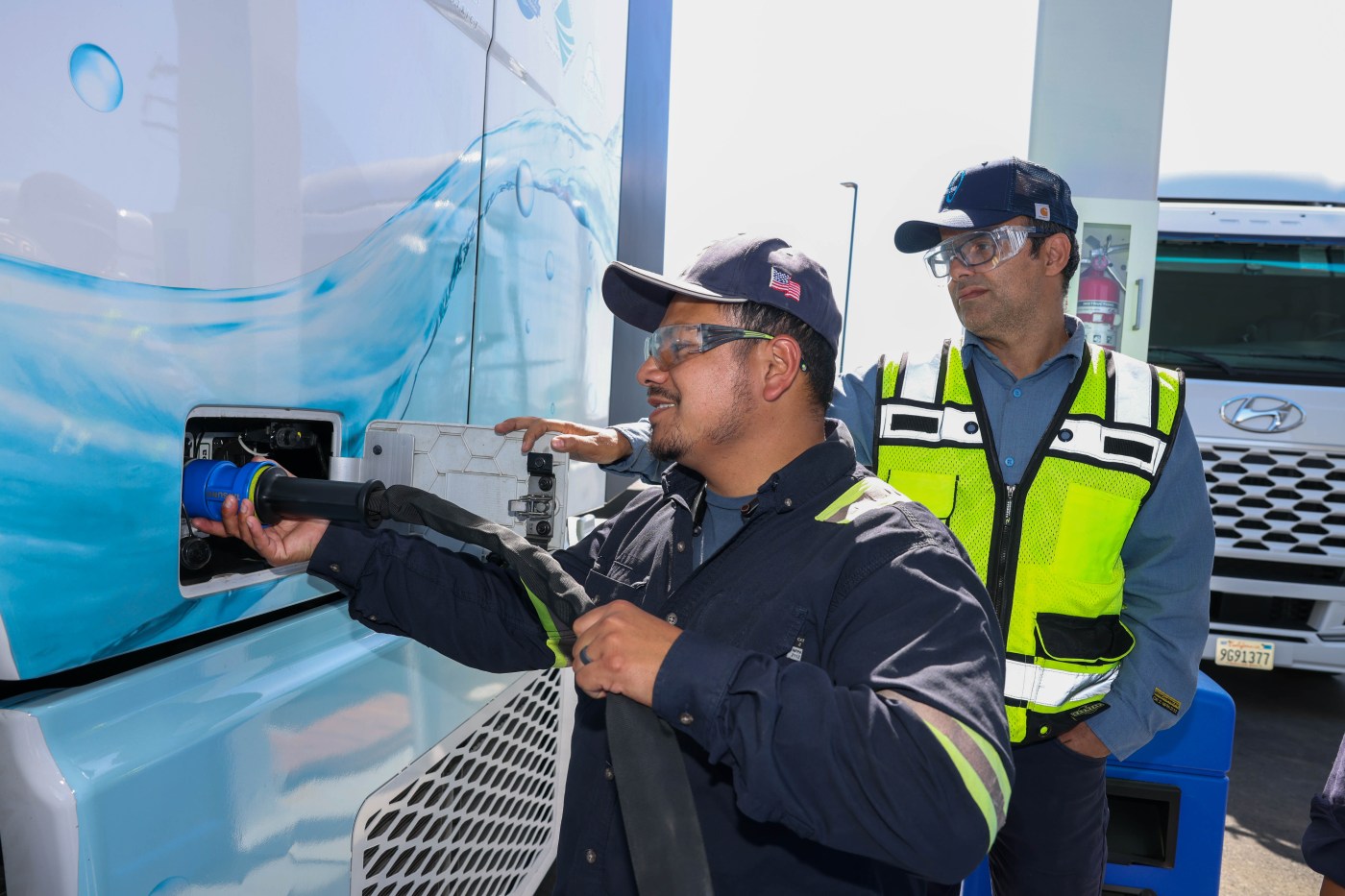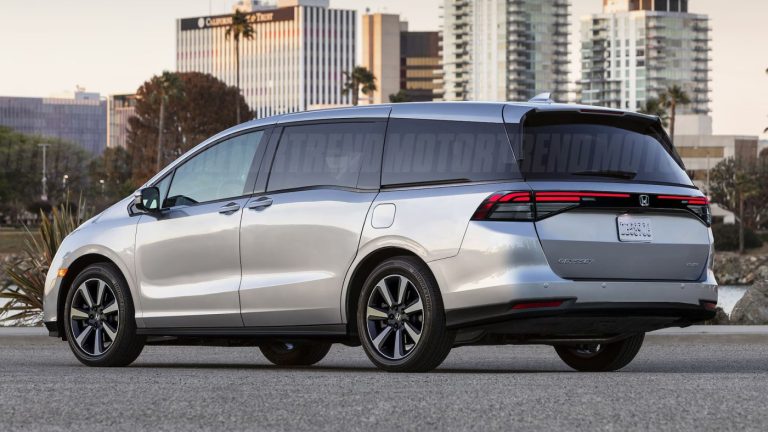OAKLAND — The first commercial truck hydrogen fueling station in the nation, set to open this summer in West Oakland, has the potential over the next six years to stop nearly 25,000 metric tons of carbon dioxide from fouling the air and harming nearby residents, the equivalent of greenhouse gas emissions from nearly 28,000 cars, environmental experts say.
The station’s arrival comes just a year after California air regulators approved first-in-the-nation rules to ban the sale of new diesel big rig trucks statewide by 2036, the latest step in the slow but steady phase-out of fossil fuels in the Golden State. The rule will affect 1.8 million trucks in California — everything from 18-wheeled semis to delivery vans, garbage trucks and so-called drayage trucks that move shipping containers at ports like Oakland’s.
While most of the attention on transitioning the commercial fleets to clean technology has focused on electric vehicles, some say that hydrogen fuel offers many benefits that big rigs powered by heavy electric batteries cannot.
Mary Nichols, the former chair of the California Air Resources Board, said hydrogen-fueled trucks can carry more cargo and heavier loads.
“Overall the efficiency is good and you don’t have to keeping charging all the time,” said Nichols. “It’s been a policy for a long time to try and support this type of change.”
There are fewer than 2,000 zero emission medium and heavy-duty vehicles on the road in California, according to the California Energy Commission. Of those, 1,369 are school and city buses, 306 are trucks and 268 are delivery trucks.
One nagging problem in the move to cleaner trucks is the lack of refueling stations that enable fleets to travel long distances. A typical EV big rig has a 200-300 mile range. A rig powered by a hydrogen fuel cell can more than double that range before refueling.
Some help may be on the way. California is on track to build the nation’s largest clean hydrogen hub by 2030. The $12 billion project will include pipelines, trucks and buses, fueling stations and liquefaction facilities, according to the University of California, a project partner.
The new ecosystem is expected to reduce up to 2 million metric tons of carbon emissions a year and create 220,000 green jobs, UC officials said. Federal, state and industry money is earmarked for the project, which is expected to generate $2.95 billion a year in economic value, including healthcare savings from reduced pollution, officials said.
Truckers in the Bay Area, however, won’t have to wait until the state builds its hydrogen network.
FirstElement Fuel station, just three miles from the Port of Oakland, will initially deploy 30 Hyundai hydrogen-powered trucks operated by Global Expedited Transportation Freight, an Atlanta-based corporation that will hire the truck drivers. The station will eventually have the capacity to fuel up to 200 hydrogen trucks and roughly 400 cars a day.
The $53 million project was funded with grants from the California Air Resources Board and the California Energy Commission.
“The reason this project is so important for the public is the number one source of air pollution that kills people is trucks,” said Oakland Councilmember Rebecca Kaplan. “Cleaning up the emissions from the trucks is one of the most important things in terms of human health impact, it is the cause of asthma, cancer and even premature birth in these disproportionately impacted communities.”
West Oakland residents who live near the Port of Oakland and the I-880 freeway are exposed to air concentrations of diesel pollution that are almost three times higher than average background levels in the Bay Area, and 71% of that comes from truck traffic, according to a health risk assessment by the air board.
Trucks leave the Ben E. Nutter Terminal at the Port of Oakland, Calif., on Thursday, Oct. 22, 2015. (D. Ross Cameron/Bay Area News Group)
And while trucks represent just 7% of vehicles on California roads, they emit 80% of the diesel soot and 70% of nitrogen oxides, a key component of smog from vehicles.
“Aside from the climate benefits, the greatest impact will be to the local communities by reducing the harmful diesel emissions from trucking in their neighborhoods,” said Shane Stephens, co-founder and chief development officer of True Zero, a FirstElement Fuel brand.
Stephens said his company has a commitment from Nikola to provide more hydrogen trucks, and that other companies, such as Toyota, and Honda are developing hydrogen fuel cell products as well.
He said the number of trucks using the station will be modest for the first year but should increase as more fleets transition to hydrogen fuel. Stephens added that a hydrogen fueling station in Kettleman City, along Interstate 5 on the way to Los Angeles, is already in the works.
A Hydrogen fuel truck parked during a news conference rehearsal at the new Hydrogen fueling station True Zero operated by FirstElement Fuel in Oakland, Calif., on Wednesday, May 1, 2024. The Hydrogen fueling station is the first of its kind opened in the United States, near the Port of Oakland. (Ray Chavez/Bay Area News Group)
Still, not everyone believes hydrogen is the answer to replacing dirty diesel fuels.
David Cebon, a professor of mechanical engineering at the University of Cambridge in England who studies hydrogen-powered long haul freight transport with The Hydrogen Science Coalition, said hydrogen-powered trucks are more expensive to buy and three times more costly to run.
For example, a diesel truck costs an average of $70,000 to $200,000 while electric semi trucks can sell for $365,000 to $435,000 before incentives, according to TEC equipment, although Tesla has been advertising $180,000 for its 500-mile electric semi, according to the International Council on Clean Transportation.
Meanwhile, U.S.-based zero-emission automaker Nikola Motors — which also manufacturers EV trucks, is currently selling its new hydrogen trucks for about $350,000 after incentives, according to Hydrogen Insight.
Daimler and and Volvo electric trucks report going about 200-300 miles on a single charge, while Tesla reports that its new electric big rig can travel up to 500 miles on a single charge, according to the company.
Related Articles
NASA researchers bid farewell to ‘flying laboratory’ at Ames Research Center
California moves closer to requiring new pollutant-warning labels for gas stoves
The surprising force stalling climate progress: California restaurants
Big rigs in California are getting cleaner — but can long-range targets for trucks be met?
Few stations and $200 to fill up: Life on California’s ‘Hydrogen Highway’
The Nikola hydrogen fueled semis have a 500-mile range, but the high cost of hydrogen adds up when it comes to refueling — by some reports as much as $1,800 to fill the tank. Then again, the refueling is quick — 10-20 minutes, whereas electric recharging can take a minimum of 45-90 minutes to recharge.
Cebon’s coalition maintains that given the large amount of energy needed to produce, transport and store, hydrogen it is a very inefficient energy carrier.
It’s likely that the future of clean trucking will include both options and already there are examples of both methods being used.
A new EV fueling station for large food trucks just opened in Gilroy. Shell continues to run three hydrogen stations in California for industry and heavy-duty vehicles, according to a report by Autoblog. That report also said Shell will continue allotting $1 billion annually toward heavy duty hydrogen as well as atmospheric carbon capture and storage. Shell did not return emails or calls seeking comment.
West Oakland climate activist Margaret Gordon, a founding member of the West Oakland Environmental Indicators Project, said she has been advocating for a fuel change for trucks that use the Port of Oakland for the last 17 years.
“This is the first time that a collection of various institutions, regulatory agencies and community activists came together to help impact the community,” she said.












